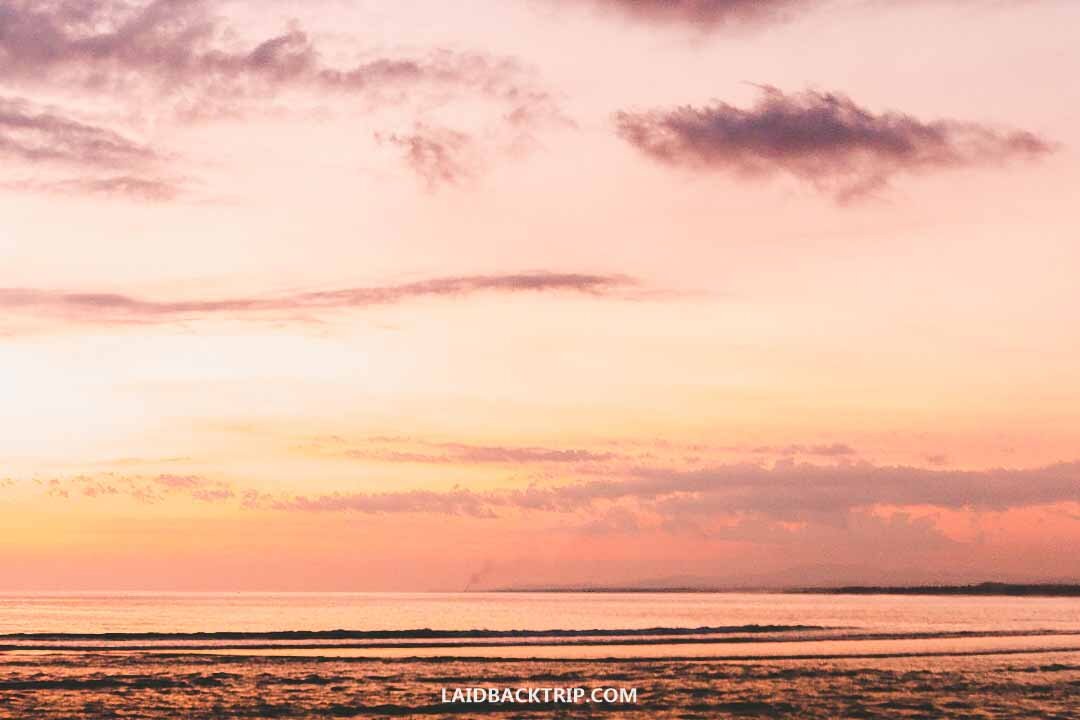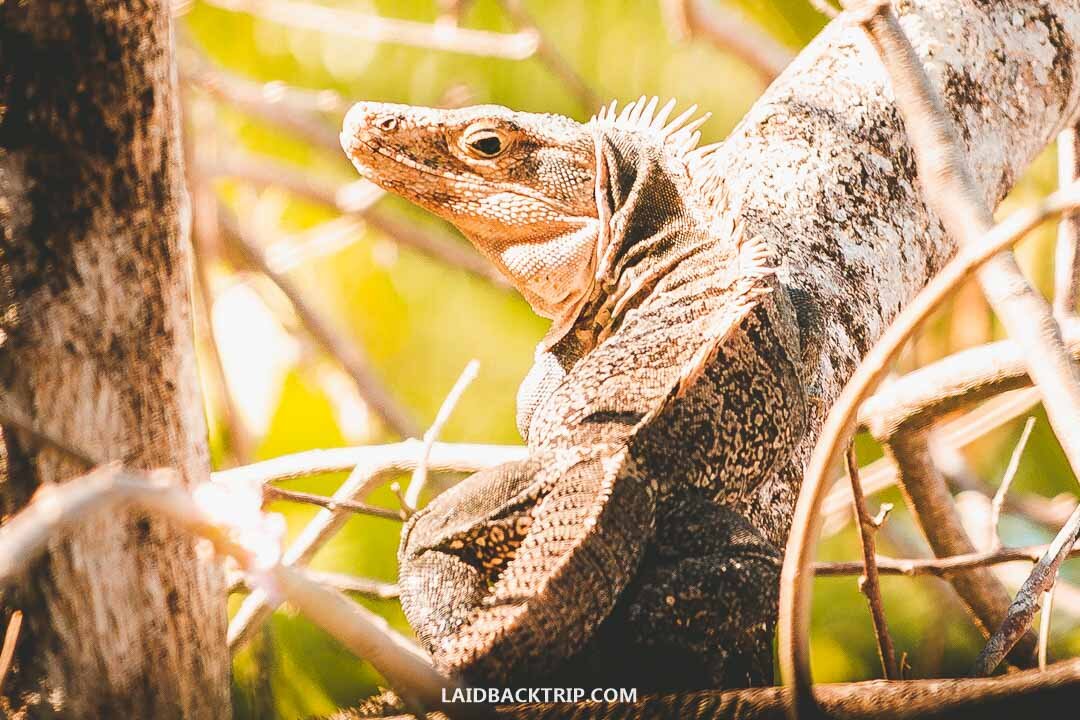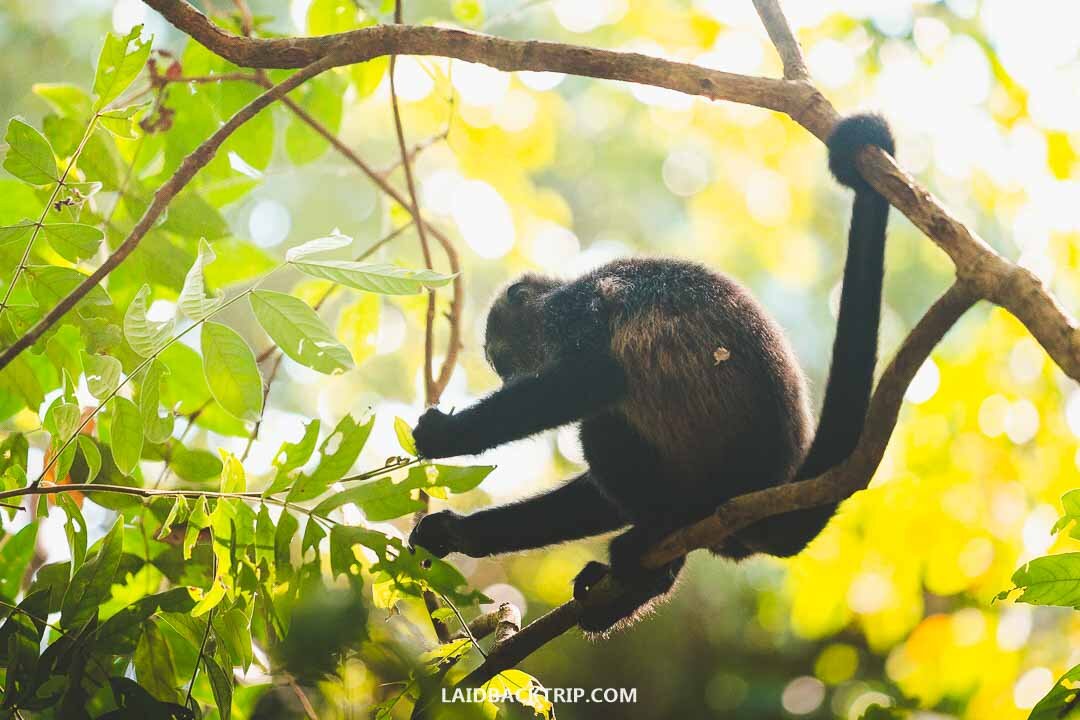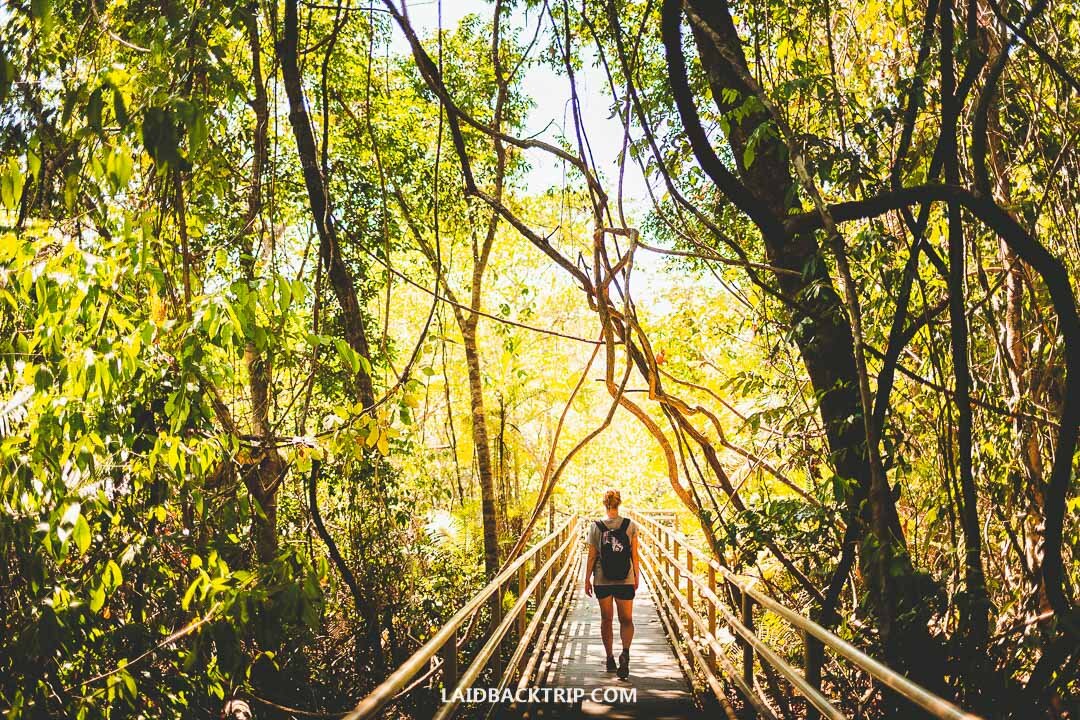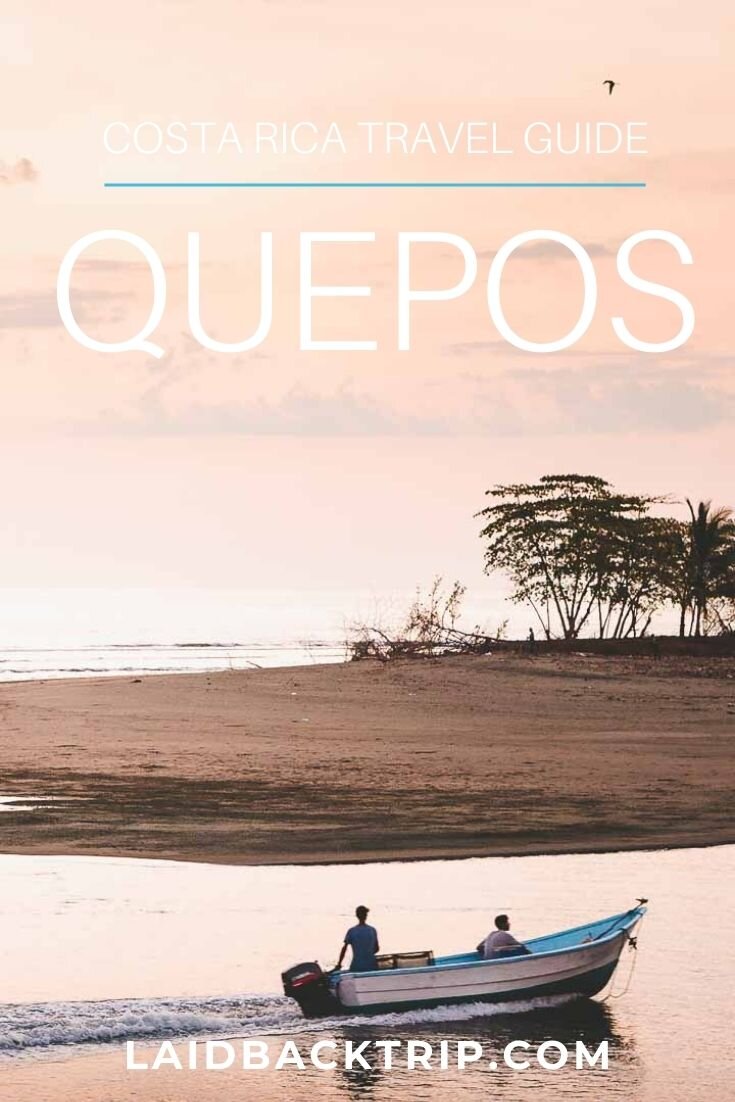A Visitors Guide to Quepos, Costa Rica
Are you wondering what to do in Quepos, Costa Rica? Our travel guide includes top activities, best attractions, places to visit, tips on accommodation, when to go, and advice on whether it's better to stay in Quepos or Manuel Antonio.
Quepos is a small town in Costa Rica mostly known as a gateway to Manuel Antonio National Park. The town is located only 100 kilometers south of the capital San Jose, making it a popular place to visit by both international travelers and locals on day trips or holidays.
Furthermore, Quepos is a coastal town in Puntarenas province sitting on the shores of the Pacific Ocean, and tourism revolves around the natural beauty of the area.
And we are not afraid to say, that most visitors put Quepos on their Costa Rica travel itinerary.
The days when Quepos was just a sleepy fishing village are long gone, and the development is quite striking.
Manuel Antonio National Park receives almost five hundred thousand visitors each year, so it's not that surprising that tourism in the Quepos area plays a vital role in the everyday life of many locals. On the brighter side, it makes the visit of all top attractions in Quepos very easy.
Although the national park is the main attraction in the area visited by thousands of tourists each year, there are still some additional things to do in Quepos that you shouldn't miss.
This blog post is aimed not only at Quepos, but we also included our thoughts on Manuel Antonio village, a popular alternative to this town that's located even closer to the national park.
So, here is everything you need to know about the Quepos and Manuel Antonio area before you go.
BEST THINGS TO DO IN QUEPOS
To be completely honest, there are not that many worthwhile things to do in Quepos town itself. Well, this is probably not an introduction you would have expected, but keep on reading; it gets better.
Think of Quepos as a place where you can base yourself for several days, a place where you can find hotels, restaurants, bars, banks, ATMs, stores, and other facilities you would expect from a similarly sized town.
Moreover, there are even fewer things to do in Manuel Antonio village, so it might be a good idea to base yourself there.
In general, Quepos is a bit cheaper than the Manuel Antonio area, which makes it a smart choice for those traveling on a budget.
We are going to compare whether it's better to stay in Quepos or Manuel Antonio later in the article, so stay tuned.
VISIT MANUEL ANTONIO NATIONAL PARK
Although we will try to outline more reasons to visit Quepos, the reason number one to travel to this town is its close proximity to Manuel Antonio National Park.
Manuel Antonio National Park is one of the best places to visit in Costa Rica, and the chances to spot the wildlife are really high there. The national park is famous for its incredible biodiversity despite the fact that the area occupied by the park is quite small.
Simply put, the variety of plants and animals you can see in this coastal rainforest is unique, and you won't find many places in the world as diverse as this one.
The highlight for us was seeing the howler monkeys in their natural habitat putting on a loud show early in the morning, though we saw many more animal species there.
If you get in the park early, expect to see sloths, raccoons, frogs, birds, or more monkeys. An early start is essential to increase your chances of spotting the animals in the wilderness.
The national park is known not only for wildlife watching opportunities but also for golden sand beaches and trails through the coastal rainforest.
Due to its easy access and its small size, the national park might feel crowded at times, but the Costa Rican government put a limit on the number of visitors per day, resulting in a better overall experience.
It's never a bad idea to hire a local guide to see even more animals you wouldn't be able to spot by yourself and to learn more about the local fauna and flora.
If you find the prices for tours too high, then Manuel Antonio is one of the few places where you really don't need the guide (unlike, for example, Monteverde Cloud Forest or Arenal).
Also, please don't feed the wildlife in the park no matter how cute you think it might be, and watch your belongings on the beaches as the monkeys can snatch them and disappear with your backpack in a fraction of a second.
As it's often hot and sunny in the park, make sure to bring sunscreen and plenty of water to stay hydrated.
The monkeys, sloths, or macaws can be high in the treetops, so you should bring travel binoculars with you, especially if you want to explore the national park without a guide. A telephoto lens with good reach such as Canon RF 100-500mm F4.5-7.1 is a must for enthusiast wildlife photographers.
Always stay on the designated trails for your safety.
Taking a guided Manuel Antonio National Park Tour is one of the best ways to explore this area.
The entry fee to Manuel Antonio is 18.08 USD, and the national park is open daily from 7 AM to 4 PM except for Tuesdays.
WHITE WATER RAFTING
Costa Rica is home to some finest rivers in the world that are ideal for white-water rafting. Although you won't find the famous Pacuare River here, rafting is very popular in Quepos.
There are two rivers near the town, and they both offer a slightly different experience. Both rivers are east of Quepos (and Manuel Antonio National Park), and you can find plenty of tour operators offering white-water rafting tours in the town.
Simply put, white-water rafting is one of the best things to do in Costa Rica.
If you are looking for a less challenging experience, then Savegre River is the ideal place to go rafting. Savegre River has Class II and III rapids that require less physical effort on your part while still possessing a sense of adventure.
Savegre River provides a great introduction to a bit more serious rafting for families with older kids (usually 12 years old can go rafting), but you can still have some time to enjoy the beautiful scenery.
Here, you can reserve the Savegre White-water Rafting Tour.
On the other hand, the Naranjo River has III and IV rapids; therefore, it's much more challenging, and you should be in decent shape to enjoy this activity.
If you don't have time for Pacuare River as it simply doesn't fit in your travel itinerary, but want a similar experience, then Naranjo River is a perfect replacement.
Naranjo White-water Rafting Tours are available here.
Remember that the rivers in Costa Rica are swelled and more powerful during the rainy season, which means that they are more difficult to navigate and have higher age restrictions.
The best example is the El Chorro Tour (it's a part of the Naranjo River but sold as a separate tour), which's not even run during the rainy season for safety reasons.
WATCH THE SUNSET
Being located on the Pacific Coast has its perks. Every day, as the sun sets behind the horizon, you can leisurely stroll the Paseo del Mar to admire the sun's final act of the day.
Seeing the sunset is an extraordinary experience regardless of the location, but we always thought that those Costa Rica sunsets were somewhat special.
There were always people around watching the sunset if you are worried about safety after dark. If you stay near the beach somewhere in Manuel Antonio, that's even better.
As the sunsets in Costa Rica occur around 6 PM throughout the whole year, you will have plenty of opportunities to admire this incredible show regardless of your location.
This helpful information is one of the essential things to know about Costa Rica as it affects your day-planning a lot.
ENJOY THE BEACHES IN MANUEL ANTONIO
The beaches in Manuel Antonio are insanely beautiful, but you need to pay the entrance fee to the national park to enjoy them.
Luckily, there are a few beaches outside the park that you can visit for free. There isn't a beach in Quepos where you would want to spend your free time, so you need to either take a bus or drive to get there.
Playa La Macha and Playa Tulemar are nice little beaches near Quepos. Playa Tulemar is on private property, and you can officially reach it only if you stay in the Tulemar Resort.
Playa Biesanz is a bit harder to reach, as you need to leave the car on the small parking or sideroad (it costs 4 USD to pay the guys who will look after your car) and walk for five to ten minutes through a forest.
Playa Espadilla is farthest from Quepos, though it's the most famous one of the bunch. The beach has two parts Playa Espadilla Norte and Playa Espadilla Sur. Playa Espadilla Norte is the longest beach outside the park in Manuel Antonio village.
The beach is free and gets quite crowded during the day.
The southern tip of the beach is located within the national park, and you need to pay admission to get there. This part of the beach is wonderful, and there are no vendors to bother you while lazing around.
Even though it's just a rock throw away from the famous Playa Manuel Antonio, this part of the beach remains very quiet and without tourists. Now, as we entered the national park, there are a few more beaches left for exploration.
Playa Manuel Antonio is one of the most popular beaches in Costa Rica, and while its beauty is undisputed, it often gets really crowded. Remember that you must hike through the rainforest to get there, though you will have great opportunities for wildlife spotting along the way.
Some beaches have rocky parts, so you might want to consider using water shoes to prevent cuts from stepping on a sharp rock.
Also, the sun is incredibly strong in Costa Rica, and you need to use sunscreen with high SPF to prevent getting sunburnt.
STAY IN MANUEL ANTONIO
At the beginning of this blog post, we made things a bit more complicated by saying that you don't have to stay in Quepos at all.
At some point in planning your trip to Manuel Antonio National Park, you will realize that you can either stay in Quepos or Manuel Antonio village.
Although you can't stay inside the national park as there are no hotels or lodges, the village of Manuel Antonio on the borders of the park is the closest option you can choose when it comes to accommodation.
Manuel Antonio has an excellent selection of accommodation ranging from cheap hostels for backpackers and long-term travelers to luxury hotels for vacationers who don't mind splurging a bit and prefer to travel in a more comfortable way (and anything in between).
A crucial thing to understand about Manuel Antonio is the fact that the village stretches for several kilometers and has many branches with sideroads, and it's not easy to decide where to stay there.
If we put it bluntly, Manuel Antonio is not some centralized village but a road lined with hotels offering a more distinct experience than Quepos.
Manuel Antonio area is often considered a bit safer, has better hotels, and it's closer to nature and beaches. In fact, most travelers prefer staying in this area over the Quepos for the reasons mentioned above.
On the other hand, it's more expensive, and you sort of might lose the spirit of exploring the area outside your hostel or hotel as there is simply no reason or need for it.
Furthermore, if your accommodation you choose to stay in doesn't have an onsite restaurant, you might end up spending more money on eating out at nearby restaurants.
So here are some of our final thoughts on Manuel Antonio vs. Quepos.
It's not that simple that Manuel Antonio is better or worse than Quepos; both locations have their pros and cons that only you can compare.
In the end, we decided to stay in Quepos. We found there some nice and basic accommodation, didn't mind using the public bus to get around the area as we traveled long term at the time and had plenty of time.
Moreover, we enjoyed the surprisingly not that touristy vibe of the town (compared to Manuel Antonio).
Being said that, if you are a first-time visitor to the area, we probably would recommend you to stay in Manuel Antonio as it's closer to the beaches and you can find superior accommodation there.
TAKE THE CHOCOLATE TOUR
Chocolate tours are super popular activities in Costa Rica for families with kids (but not only for them). These tours are safe, educative, and, most importantly, fun.
You will learn about planting and growing cocoa beans or harvesting and the history, cultural impact, and connection to the environment. Tasting the delicious blend of flavors at the end of the tour is the icing on the cake.
During the tour, you will have the chance to learn more about other plants grown in the fertile gardens, such as sugarcane, vanilla, cinnamon, or pineapple, so you won't have to get bored.
The local guides are knowledgeable and very enthusiastic, and the tour will allow you to understand the whole process of making chocolate in Costa Rica in an entertaining way.
Clearly, you won't find a chocolate farm directly in Quepos, so you need to drive for a bit (it takes only 10 minutes by car to get there) or book the Quepos Chocolate Tour that includes transportation.
EXPLORE THE MANGROVES
Located northwest of Quepos, Isla Damas is home to an intriguing and delicate ecosystem that's worth a visit.
This place is known for mangroves that are best explored on a kayak or boat tour. As a matter of fact, mangroves are a great place for wildlife watching, and you can see monkeys, sloths, birds, caimans, snakes, and much more. Mangroves are one of the most underrated ecosystems, but they are definitely worth a trip.
The kayaks are narrower and can more easily navigate through the dense network of mangroves, and the paddling exercise is always an awesome way to stretch your stiff body. If you don't feel like getting too close to nature, then the boat tours are a better choice for you.
A word of warning, though. Seeing the wildlife in the wilderness is never guaranteed as it depends on many factors.
There are also those days when you can barely see anything, so it's always better to lower your expectations before you go. It's not only the case of these charming mangroves but all of the natural attractions in Costa Rica.
You can book the tours in advance here - Damas Island Kayaking Tour or Boat Tour to Damas Island.
FISHING
Fishing used to be one of the main sources of income for many families in the Costa Rican coastal towns. The times have changed, now recreational fishing is what attracts 'pescadors y pescadores' from all over the world.
If sportfishing is your thing, then consider trying this activity in Quepos. Tours include either offshore fishing, inshore fishing, or deep drop fishing, so it's only up to your preferences and travel budget in which tour you want to participate.
Costa Rican shores are rich with marine life, and the regulations are favorable for angling (keep in mind that you need to obtain a fishing permit), so this activity is getting more and more popular each year.
The best part about this activity is that you can plan your fishing trip for any time of the year, though the season definitely plays an important role, and your catch can depend on it.
And what can you catch in the waters around Quepos? Yellowfin tunas, snappers, groupers, mahi-mahi, marlins, or sailfish are the most common catches in this area.
WALK THE HANGING BRIDGES
The beauty of Costa Rica lies in the fact that you can always find some hidden gems or less-traveled paths, even in top travel destinations such as the Quepos area.
Rainmaker Conservation Park is a great off-the-beaten-path alternative to the busy Manuel Antonio National Park. There are some nice trails in the park that feature suspension bridges (they are a bit different from those in Monteverde or Arenal), natural pools, and waterfalls.
Make sure to bring a bug repellent, and swimsuit, and water shoes as you can take a dip into natural pools.
The entry fee is 20 USD (without a guide).
Rainmaker Conservation Park is located roughly 20 kilometers northwest of Quepos, and you can get there in 30 minutes by car.
If you are looking to find an even more remote place, then you can go to Los Campesinos Reserve, though it's a bit harder to get there by car. The gravel road has many bumps and rocks, and you should have a 4WD or at least a car with a higher clearance.
Either way, drive slowly in the more difficult sections. Though the reserve is located only 24 kilometers east of Quepos, you will need approximately an hour to get there.
And what can you expect from Los Campesinos Reserve?
A couple of suspension bridges, diverse fauna and flora, waterfalls, natural pools suitable for swimming, and some trails through the rainforest. The admission to the reserve is 10 USD.
We would recommend you to visit either of these places only if you have plenty of time. Otherwise, it's perfectly fine to skip them (or visit only one of them).
IS QUEPOS SAFE?
Staying safe is the crucial part of every trip abroad. From our experience, we felt safe in Quepos, but we always recommend using common sense when walking around the town.
Quepos central area gets lively after dark, as there are plenty of places where you can go for dinner, drinks, or even music. The town's mood closer to midnight changes a bit, and you can meet some shady characters there.
Don't flash your valuables, or even better, leave them at the hotel. Despite the fact that Costa Rica is the safest country in Central America, you are still a tourist who needs to know where you can go and which areas are better to avoid.
If you are worried about walking alone after dark, take taxis when getting around, or travel with a group of people.
Moreover, you can always stay in Manuel Antonio, which consists mostly of tourist hotels and restaurants.
Keep your car locked all the time, and never leave any valuables in there. When searching for accommodation, make sure they have private parking.
Some beaches are not safe for swimming in Quepos, and we believe that nature presents a greater danger than the city.
Lastly, tap water is often drinkable in Costa Rica, but for some reason, we didn't trust the water source here in Quepos.
You can avoid buying single-use plastic bottles to lower your plastic footprint by using either SteriPen or a water bottle with a filter.
Travel Insurance
We never leave home without travel insurance that was designed to cover our expenses if something goes wrong during the trip.
Travel insurance protects against theft, flight delays, injury, illness, cancellations, and much more.
World Nomads provides travel insurance for travelers to cover their trip essentials, including sports and adventure activities.
SafetyWing is affordable travel insurance for backpackers, long-term travelers, and digital nomads.
Travel smarter and safer!
WHERE TO STAY
Although you can find some good hotels in Quepos, the town can't compete with what lies outside its limits. The thing is a bit more complicated, though.
As soon as you take a look at a map, you will realize that the town of Quepos lies roughly seven kilometers away from the national park. Somewhere in the middle, you will find a small village of Manuel Antonio.
Unfortunately, everything that lies outside the southern border of Quepos is considered Manuel Antonio village. And there are many hotels along those seven kilometers making the whole process of searching for accommodation even more challenging.
The list of hotels in Manuel Antonio is overwhelming, so we decided to select one hotel in Quepos and two in Manuel Antonio to make your decision easier.
One more travel tip. It's really hot in Quepos, make sure to book an air-conditioned room when possible.
Here is our choice of the best hotels in Quepos and Manuel Antonio.
Budget | Wide Mouth Frog - If you are looking for a budget hostel in Quepos, then you might want to look into Wide Mouth Frog. The hostel has an excellent location in the town's center, and it's very close to the bus station. Rooms are basic but clean, and there is an outdoor pool and shared lounge on the terrace.
Mid-range | Millenium Manuel Antonio - Located at the entrance to the national park, Millenium Manuel Antonio offers onsite parking, an outdoor pool, and nice rooms with comfortable beds. The outdoor shared kitchen is available for guests. The public beach is only a short walk from there. This accommodation is one of the best values for your money.
Luxury | Parador Resort and Spa - This luxury resort in the middle of the forest offers rooms with ocean, garden, or jungle views, two bars, three onsite restaurants, and three swimming pools. A free shuttle to the beaches is included.
GET AROUND
Quepos is a small and compact town, and you can easily get around it on foot. However, if you want to visit some other areas outside the town, then the most convenient way to do it is by car.
It's very easy to get from Quepos to Manuel Antonio by bus. Buses frequently run between the town’s bus terminal, village, and national park (it's usually every twenty or thirty minutes), and you won't have any difficulties traveling between these two areas.
Buses are cheap and reliable and allow you to get around the area easily.
If you don't want to lose your time by waiting for a bus, you can take a taxi to get to Manuel Antonio National Park or somewhere else.
Taxis are more expensive, but you can split the cost if you travel in a group.
HOW TO GET THERE
Quepos is not a remote place and is well-connected with the rest of the country. Therefore it's easy to get there from most corners of Costa Rica.
BY CAR
The easiest way to get to Quepos is by rental car. We talk about it in our every blog post about Costa Rica, and this section focused on getting to Quepos is no exception.
Renting a car in Costa Rica is easy and convenient.
Keep in mind that driving in Central America is different from what you are probably used to. The traffic can be unpredictable, and roads are often narrow and full of potholes.
It's not recommended to drive after dark in Costa Rica, but if you need to travel during this time of the day, drive slowly.
There is another even more convincing reason not to drive at night as you will also miss the scenic part of the ride. Costa Rica is an extraordinary country, and being able to see its beauty during the daylight will make your road trip even more memorable.
The road from Quepos to Manuel Antonio National Park is in good condition and doesn't require a 4WD.
Also, the roads leading to Quepos from neighboring Costa Rican towns are paved and in good condition as well.
BY BUS
You can travel directly to Quepos from San Jose by bus, and the ride takes approximately three hours.
Direct buses frequently run between surfers town of Jaco and Uvita (known for whale watching) as well; they are cheap, safe, and reliable.
They are not as convenient as rental cars, but you don't need to worry about the driving part and save some money, which is often handy if you travel long term or on a strict budget.
Public buses depart several times a day between these destinations, but it's always advised to check the current timetables as they change a lot in Costa Rica.
BY SHUTTLE BUS
Shuttle buses are popular with tourists who don't want to rent a car but still want to arrive on time, though they do cost a bit more.
The shuttle bus ride from Quepos to Jaco takes about an hour and costs around 40 USD. The shuttle from Quepos to Uvita costs 40 USD as well, and you will reach it in an hour and a half.
WHEN TO GO
The best time to visit Quepos depends on your activities, though you can see the town and the national park year round.
Needless to say, the best time to visit Quepos and Manuel Antonio is during the dry season that lasts from December to April. May to November brings the rainy season, and some activities and places can be closed or inaccessible.
The dry season is also a peak season, and you can expect higher prices for accommodation and larger crowds at the popular spots.
Either way, the weather in Quepos is hot and humid year round, something you should take into account when booking your accommodation.
Travel Resources
Here you can find links to all the travel resources we use and which you might find helpful when planning your next holiday.
Accommodation: When looking for accommodation, we usually search hotels via Booking.com or Hostelworld.
Tours: Although we love to travel independently, some places are better to visit with a guided tour.
We prefer GetYourGuide for its easy-to-use interface and solid reputation. Another great alternative is Viator.
Rental Cars: When going on a road trip, we always use Rentalcars.com, a reliable site for booking a rental car in advance.
Flight Tickets: When looking for flight tickets, you can search Skyscanner to find the best price.
Travel Insurance: World Nomads and SafetyWing cover against risks of travel.


